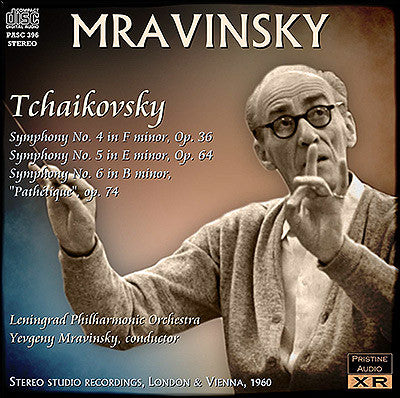
- Producer's Note
- Full Track Listing
- Cover Art
- Historic Reviews
Mravinsky's legendary 1960 Tchaikovsky Late Symphonies
Stereo DGG recordings in stunning new 32-bit XR remasters
Yevgeny Mravinsky made these recordings with the Leningrad Philharmonic Orchestra for DGG whilst on a tour of western Europe in the autumn of 1960 in sessions which took place in London (Symphony No. 4) and Vienna (Symphonies 5 & 6). Although regarded still today as pillars of the recorded canon, reviews both upon release in 1961 and, quoted here, upon reissue in the 1970s, found something lacking sonically. Likewise contemporary reviews of the currently-available DGG CDs.
My aim in carrying out a 32-bit XR remastering of the recordings was to see whether a harmonic rebalancing of the recordings might serve to eliminate these reservations, and I'm pleased to report that substantial improvements have been possible. The sound of the originals was unusually boxy for 1960, with a rather constricted top end and a lack of real depth in the bass. All three of these shortcomings have been resolved here, bringing an even greater sense of immediacy and realism to these fabulous performances.
-
TCHAIKOVSKY Symphony No. 4 in F minor, Op. 36
Recorded 14, 15 September 1960
Wembley Town Hall, London
First issued as DGG SLPM138657
-
TCHAIKOVSKY Symphony No. 5 in E minor, Op. 64
Recorded 9,10 November 1960
Großer Saal, Musikverein, Vienna
First issued as DGG SLPM138658
-
TCHAIKOVSKY Symphony No. 6 in B minor, Op. 74 'Pathétique'
Recorded 7-9 November 1960
Großer Saal, Musikverein, Vienna
First issued as DGG SLPM138659
Leningrad Philharmonic Orchestra
Yevgeny Mravinsky, conductor
Producer and Audio Restoration Engineer:
Cover artwork based on a photograph of Mravinsky
Total duration: 2hr 11:22
2.
"Mravinsky's accounts of the late Tchaikovsky symphonies have
tremendous tension and virtuosity, a sense of spiritual commitment and
emotional power that are quite out of the ordinary. Even when, as
happens at one point in the first movement of the Fourth Symphony, he
ignoes the dynamic markings he does so with such conviction that you are
left with the feeling that he is right. These transfers seem to me as
every bit as good as the originals that I played relatively recently (I
have only sampled these copies) and although my allegiance to
Mravinsky's earlier record-now deleted-with the Leningrad Philharmonic
of the Pathetique remains unshaken (DGM18334, 2/57), this later version
is still one of the most moving and thrilling accounts of the work
committed to record. These performances radiate a tremendous power, a
sense of truth and authenticity of experience and they remain for me at
any rate among the classics of the gramophone."
R.L., The Gramophone
Excerpts: 1. November 1973 (from box set reissue), 2. December 1974 (from individual LP reissues)
Fanfare Review
There’s real openness now and a sense of space in the hall and around the instruments, and the violins now soar upward into the stratosphere as if relieved of the gravity that was previously holding them captive
This is a bit of a departure from
Though this is the first time I’ve had the opportunity to review Mravinsky’s Tchaikovsky myself, I’ve consistently cited the conductor’s performances of the symphonies as referential benchmarks when reviewing other versions of these scores, and I’ve steadfastly maintained my belief that they belong in the collection of anyone who’s serious about this music. Mravinsky managed readings of these works that benefit from tense, taut, high-voltage performances, while simultaneously maintaining strict discipline so that Tchaikovsky’s neurotic emotionalism remains under control. The result is music-making that delivers tremendous dramatic punch, all the more so for its feeling of pent-up energy always on the verge of exploding.
In his producer’s note,
Since I’ve had the original mastered-for-CD
Deutsche Grammophon set in my collection for years, it was easy to
compare it to Rose’s restoration effort to hear how much of a
difference, if any, actually exists between them. First, I will say that
I think I know what
These two deficiencies have indeed been
compensated for, quite remarkably so, I’d have to say, in Rose’s
refurbishment. There’s real openness now and a sense of space in the
hall and around the instruments, and the violins now soar upward into
the stratosphere as if relieved of the gravity that was previously
holding them captive. The one aspect on which I’m not sure
The other noted improvements, however, are very welcome and more than enough to warrant a strong recommendation for this release.
Jerry Dubins
This article originally appeared in Issue 37:4 (Mar/Apr 2014) of Fanfare Magazine.

